
Features
Agronomy
Fertility and Nutrients
Taking another look at phosphate fertilizer for 2009
While phosphate (P) fertilizer prices have moderated somewhat during the winter, so have commodity prices. Heading into the spring, farmers are still asking the question, “what rate of P fertilizer should I apply, if any?”
May 4, 2009 By Bruce Barker
While phosphate (P) fertilizer prices have moderated somewhat during the winter, so have commodity prices. Heading into the spring, farmers are still asking the question, “what rate of P fertilizer should I apply, if any?”
“The question I keep hearing is whether to use or not use P fertilizer this year. With P fertility, there comes a point, from an economic point of view, where it doesn’t pay to use it,” explains Rigas Karamanos of Viterra in Calgary. “Even though there may be a yield drop, there is still an economic cut-off.”
One of Karamanos’ concerns is that soil test recommendations are based on old soil test databases. On the Canadian Prairies, these databases were developed based on the Law of Minimum and only on soils that were not previously fertilized with P. Today, most Prairie soils have been fertilized with P for a prolonged period of time, and many fields are testing moderate to high in P fertility.
Karamanos recently compiled yield data from 222 experiments in Western Canada based on four soil testing categories (less than 10, 10 – 20, 20 – 30 and greater than 30 lbs of P per acre) of bicarbonate extractable P levels. The analysis provided an assessment of current soil testing criteria. He found that when soil test levels were less than 10 lbs of P per acre (considered very deficient), not all crops responded to P fertilization in all cases. Conversely, when soil test levels were greater than 30 lbs of P per acre (a critical level close to sufficiency), a number of crops were still responding to high P levels. Responses in the intermediate range of soil tests were variable.
As a rule, the greater the severity of phosphorus deficiency, the greater the recommended rate of phosphate and the greater the response to its application. Based on the research, Karamanos developed a table that shows the average responses that can be anticipated based on the recommended P rate from current soil tests.
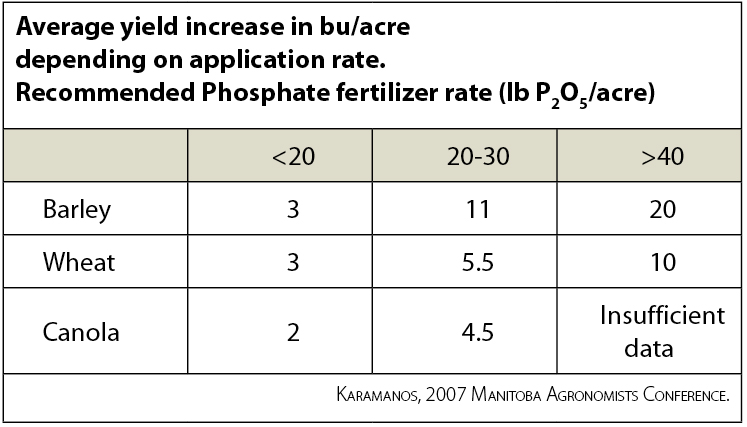 |
However, just because there is a yield response does not mean that a farmer will receive an economic response. Karamanos developed probability ranks for the economic return to the application of phosphate fertilizer from these experiments. At prices of approximately 45 cents for one pound of P2O5, the return to $1 for every $1 spent on fertilizer (the break-even point) can be derived for barley, canola and wheat. For example, the break-even point for $2 per bushel of barley in these experiments occurred 75 percent of the time, whereas that for $4 per bushel 92 percent of the time.
Karamanos points out that P fertilizer use efficiency is fairly low and is crop dependent. For cereals, it can range between 15 and 30 percent, and for tap rooted plants like canola, it can be as high as 50 percent. What this means is that annual use of P fertilizer also contributes to a maintenance component. Prolonged P fertilizer use will result in well-supplied labile P pool (a pool containing all forms of potentially available P), so much so that agroeconomic benefits are derived with the first 15 to 20 lbs of P2O5 applied says Karamanos.
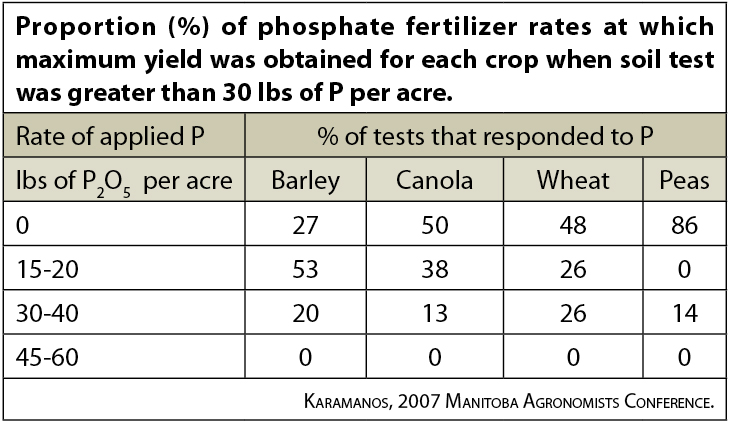 |
|
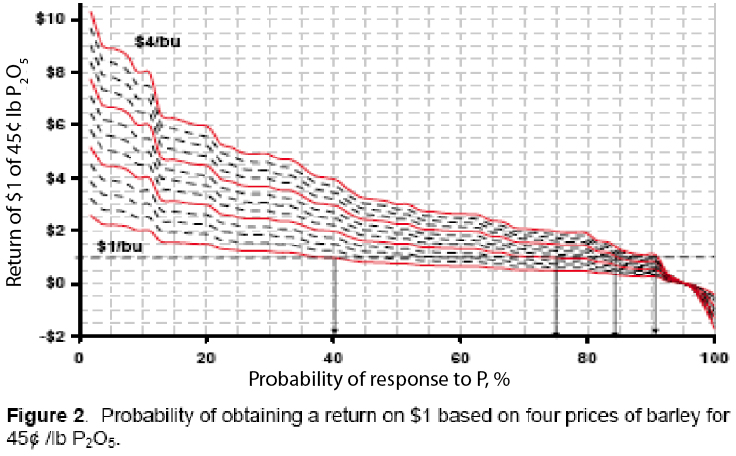 |
|
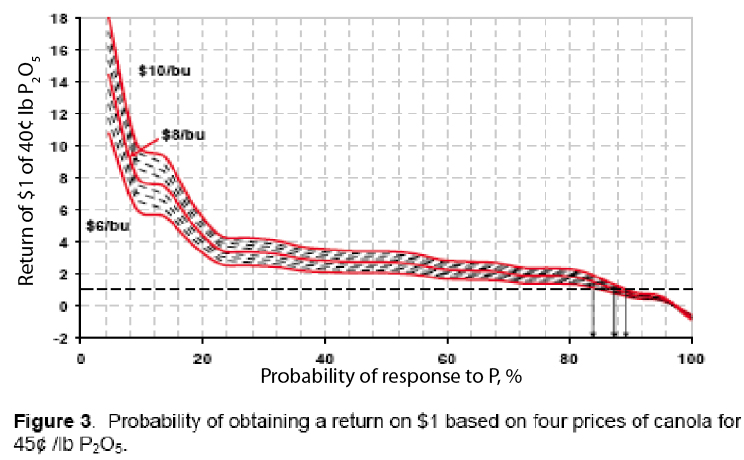 |
|
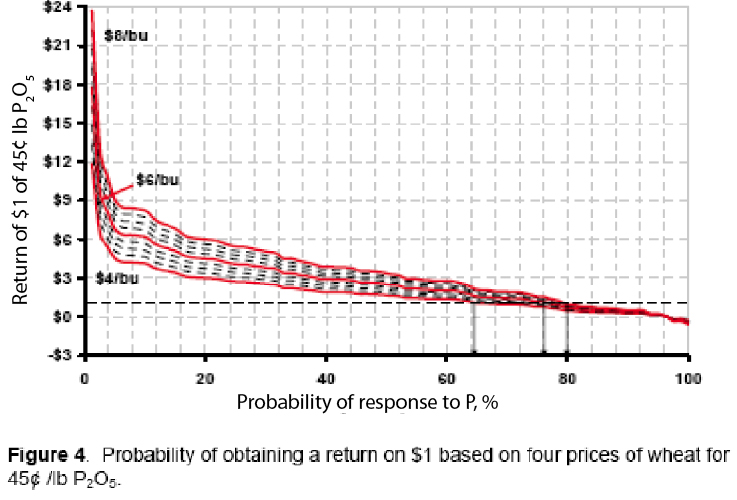
|
An example comes from the results of a canola experiment carried out at Olds, Alberta with a soil test of 25 lbs of P per acre. Maximum yield (60 bu/ac) of a canola hybrid was obtained with 18 lbs of P2O5 per acre in spite of the crop removing some 47 lbs of P2O5 per acre. Application of an additional 18 lbs of P2O5 per acre did not influence the yield.
How much P for 2009?
Karamanos says that based on these research trials, and several others across the Prairies, the most important thing to look at for 2009 is at what level P fertilizer will deliver economic returns. He is currently developing an Excel spreadsheet for N and P fertilizer applications that will help provide guidelines. It is based on the economic returns for the fertilizer as determined by the yield increase multiplied by the price per bushel minus the fertilizer rate multiplied by the fertilizer price.
N recommendations are relatively straightforward, and the calculation will provide a recommendation that will provide $1.50 return for every $1 input. P recommendations are generally more problematic, since P fertilizer responses are so variable. “There is a real clash between agronomic recommendations and economic recommendations. For example, in some calculations, the agronomic recommendation is for 20 pounds per acre of P2O5 for sufficiency applications, but that produces a negative return,” he explains.
If using soil test levels for 2009, Karamanos recommends farmers consider their P fertility levels to help guide their fertilizer plans. If the soil test levels are above 30 lbs of P per acre, the so-called critical level, then some crops may be candidates for cutting back P fertilizer rates. For example, 50 percent of canola fields, 48 percent of wheat and 86 percent of peas did not respond to P fertilizer application at this soil test level.
“On fields above the critical soil test level of 30 lbs of P per acre, I think you can adjust P fertilizer rates in the short term. In the long term, though, cutting back will eventually catch up to you, because P fertilizer applications contribute to long term sufficiency of soil P,” explains Karamanos.
For soils low to medium in P fertility (less than 30 lbs. P), 15 to 20 lbs of P will give maximum economic yield, in the short term. In the longer term, higher rates of P will be required to build sufficiency and improve P fertility.